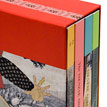| Gérard de Nerval |
Chantilly |
Here are the two towers of Saint Leu d’Esserent, the village on
the height,
separated by the railway from the part that borders the Oise. You rise
toward Chantilly while going alongside high, solemn sandstone hills,
then
there’s a bit of the forest. La Nonette shine s in the fields that
edge the last
houses of the town. La Nonette, one of those sweet little rivers where
I used
to go crayfishing. On the other side of the forest flows her sister,
the Thève,
where I almost drowned for not wanting to seem cowardly to little Célénie! s in the fields that
edge the last
houses of the town. La Nonette, one of those sweet little rivers where
I used
to go crayfishing. On the other side of the forest flows her sister,
the Thève,
where I almost drowned for not wanting to seem cowardly to little Célénie!
Célénie often appears in my dreams, like a water nymph,
a naïve
temptress, wildly inebriated by the scent of the fields and crowned with
water parsley and water lilies, showing, in her childish laugh, between
dimpled cheeks, the pearly teeth of an undine. And of course the hem
of
her dress was often wet, as befits girls like her. You had to pick flowers
for
her along the marly edges of the ponds of Commelle or among the rushes
and osier beds that border the dairy farms of Coye. She liked the grottos
lost in the woods, the ruins of old chateaux, the collapsed temples whose
columns were festooned with ivy, the home of the woodcutters, where she
sang and recounted the old legends of this area: Mme. de Montfort, a
prisoner
in her tower, who sometimes flew off as a swan, sometimes frisked
about as a beautiful carp in the moat of her castle; the pastry chef’s
daughter
who delivered cakes to the Count d’Ory and who, forced to spend
the
night with her lord, asked for his dagger to open the knot in her lacework
and stabbed him in the heart; the red monks who carried off women and
hurled them into underground caverns; the daughter of the Sire de
Pontarmé, smitten with handsome Lautrec and locked up for seven
years
by her father, after which she died; and the knight, returning from the
Crusade, who used a thin golden knife to unstitch her shroud of fine
linen,
and when she came back to life she turned out to be a vampire thirsting
for
blood… Henri IV and Gabrielle, Biron and Marie de Loches, and
I don’t
know how many other tales that peopled Célénie’s
memory: Saint Rieul
speaking to the frogs, Saint Nicolas reviving the three children chopped
up
like pâté by a butcher in Clermont-sur-Oise. Saint Leonard,
Saint Loup,
and Saint Guy have left in these regions a thousand examples of their
sainthood and their miracles. Célénie climbed up onto the
rocks or onto the
druidic dolmens and told these stories to the young shepherds. From the
old
area of the Sylvanectes, that little Velléda left me memories
that time
revives. What became of her? I will find out around La Chapelle-en-Serval
or Charlepont or Montméliant… She had aunts everywhere,
endless numbers
of cousins: so many dead among them, and no doubt many unhappy
ones, in a land that was so happy back then!
At least Chantilly bears its poverty nobly; like these old gentlemen
in
white linen with their irreproachable bearing, it has this proud attitude
that disguises the faded hat or the worn-out clothes… Everything
is clean,
organized, circumspect; the voices resonate harmoniously in the sonorous
halls. One senses the habit of respect, and the ceremony that formerly
reigned in the chateaux rules to some degree the relationships among
the placid inhabitants. Chantilly is filled with very old retired servants,
walking
their limping dogs. Some of them have become masters, taking on the
venerable look of the old lords that they served.
—
For the complete article purchase The
Sienese Shredder #1
Back to The Sienese Shredder #1
| 

